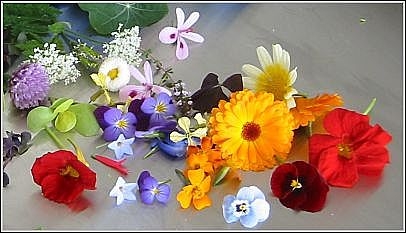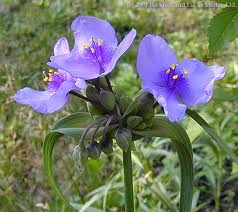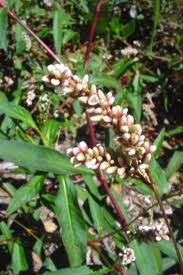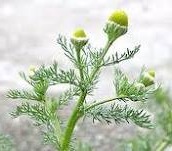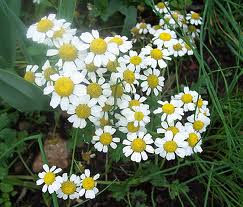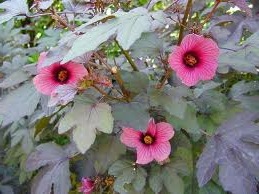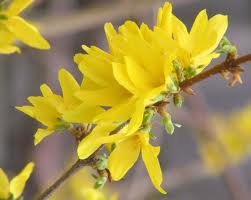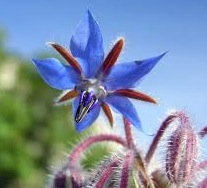Spiderwort, Marigolds, Rosemary, Smartweed, Pineapple Weed, Chamomile, False Roselle, Lavender, Forsythia, Borage
Every time I see a spiderwort I think of Pocahontas, the 11-year old Indian girl who save the life of Captain John Smith (see my separate article about them and spiderworts.) There are many reason to praise the mild spiderwort. Its blossom can be candied or tossed plain into salads to add color. There are also ruby and white spiderworts. The blossom are open for only a day but that’s okay because the spiderwort has many blossoms waiting to open. With no particular flavor though with a hint of sweetness the flowers are available throughout their growing season. See separate article on site and video.
There’s a lot of Internet misinformation about marigolds. All of them are edible from a non-toxic point of view. The more important question is which ones have an agreeable flavor? All of these get the culinary nod: Tagetes lucida, Tagetes patula, and Tagetes tenuifolia. Their flavor is citrusy. Usually only the petals are eaten. No green parts. I also use them for yellow coloring in various dishes. Our three marigolds are called the “poor man’s saffron” along with the Calendula.
I can remember the first time I saw rosemary growing in the wild in North America. I was on a business trip to California. Of course it grows wild in its native Greece. There it is called ???????????? (then-dro-LEE-vah-row.) Students in ancient Greece wore it around their necks in garlands or braided it into their hair thinking it improved their memory. In English Rosemary means “remembrance.” I have two bushes of it growing in my yard. The light blue blossoms are sweet, spicy, pungent and taste of rosemary.
This next blossom is either love or hate in my foraging classes, the Smartweed, or Polygonum. I usually ask for a student volunteer to try a small amount. I also ask for someone who likes hot peppers. Once I’ve got the propert victim…ah.. volunteer I have them chew a very small portion of a leaf. It has a slow-to-get-started burn but then it grows like a red pepper heat rather than black pepper. The blossom are even hotter and fire up quicker. But, they have a bitter aftertaste and a perfume quality. Several of the Polygonum species heat up. The heat varies from species to species. In some the leaves can also be used as a green but they are a vasoconstrictor, read they can raise blood pressure in some.
Most people don’t think of an edible wild flower growing in the middle of your driveway. Our driveway was hard-packed sand and gravel. Every summer it sprouted a determined crop of Pineapple Weed, Matricaria matricarioides. I noticed our horses, which doubled as our collective lawn mower, didn’t eat them. That led to my investigation. The weed is pineapply or applish and related to the next edible flower, Chamomile. Make a tea with the small flower heads. See separate article on site.
Three a.m. has to be the absolute worst time of any day. And when I’m awake then I make myself a cup of chamomile tea. The small flowers taste like the tea, on the sweet side and apple-ish. In a publication North Carolina State University warns that the flowers contain “thuaone” but that is a misprint which has since been proliferated over the Internet. I don’t cut and paste. I do my own research and write every word myself. That’s why there are so many typos. 😆 Chamomile has very low amounts of thujone, which is credited in significant amounts to getting people high. It’s one of the compounds in Absinthe. I’ve had Absinthe in Greece and the liquorish liquor did nothing for me. All chamomile tea does for me, and most, is make me sleepy. If you are allergic to ragweed, however, you might want to avoid chamomile. The two plants are related and chamomile can bother some people with a ragweed allergy.
Many a hibiscus flower can go into salads and the like but I don’t know how many I’ll cover because most of them are virtually flavorless but they are pretty and add texture. I happen to like the False Roselle, Hibiscus acetosella, because beside the edible pink flower the leaves are edible as well, raw or cooked. I use the young leaves for salads and stir fry. They keep their color. A close relative, Hibiscus sabdariffa is the real roselle and is also known as the “Florida Cranberry” or the “Cranberry Hibiscus.” A tart juice can be made from its fat calyxes. Its blossoms are edible as well. To see a related article click here.
Lavender is an old stand-by found in many home gardens including mine. Its flavor is flowery, sweet and citrusy. Lavender has been used to flavor bread, cookies, jelly, beef, wine, sauces, stews, and custards. The blossoms are an attractive addition to champagne. The blossoms are also used around the house to impart a nice aroma from bedding to baths. It is also slightly diuretic.
It’s easy to spot the Forsythia in the spring time. Just look for a naked shrub covered with yellow blossoms. You can find them in most urban areas and they escaped cultivation is several locations. The blossoms are spicy, minty, and slightly bitter. They add a cheery garnish to salads, particularly after a long winter. Very young leaves… very young leaves… are edible raw. Better boiled. See a separate article on site.
Where I live there are only two plants that smell like cucumber. One is a wild cucumber. The other smells like cucumber but does not taste like cucumber. But you can also cultivate a flower that has the faint taste of cucumber, borage. While it is naturalized in southern Europe most of us have to put it in our herb garden. Borage has a long history of medicinal and culinary use. Currently it is a source of gamma linolenic acid, GLA. The sweet blossoms and leaves have the taste of cucumber. The flowers are often used in salads or as a garnish and do well in many drinks. One technique is to put the blossoms in an ice cube tray and freeze them into ice cubes to be used in drinks.
Next: Edible Flowers: Part Five

